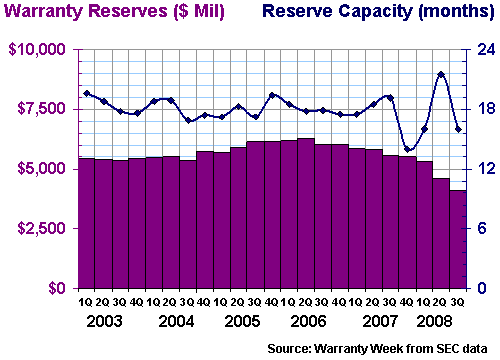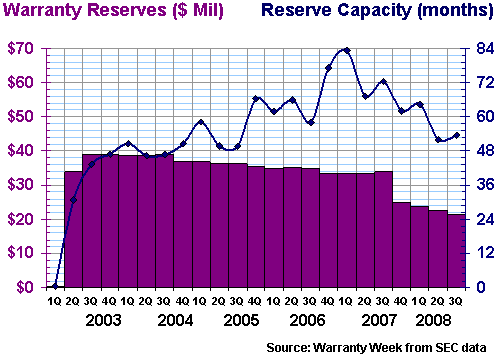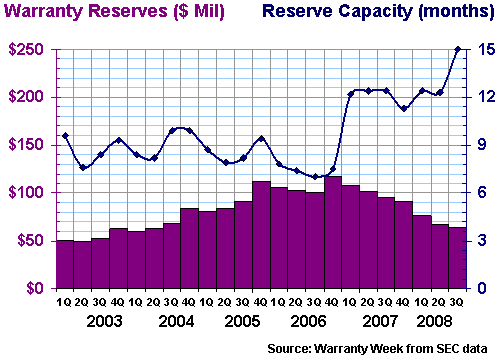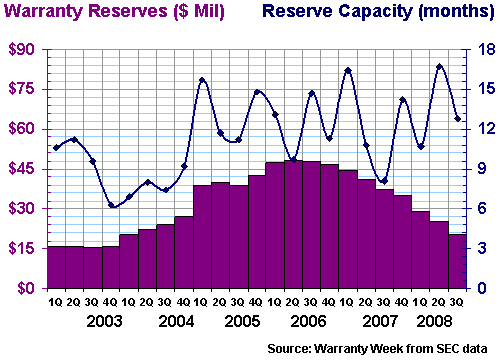Warranty Cost Cutting:
The warranty reserve balance rises and falls, along with claims and accruals, in reaction to changes in sales volumes and product quality. But merely measuring the balance doesn't provide as much insight as does using it to measure a company's capacity to pay claims.
While warranty metrics are primarily focused upon claims, alternatives such as accruals and reserves can help illuminate a company's financial position more completely.
In last week's newsletter, we focused upon accrual rates, which in a time of falling sales volumes provide a much more accurate picture of product quality trends. This week, we took the list of the top U.S.-based warranty providers as of September 30, 2007 and found the hundred with the largest warranty reserve balances as of that date. We then compared those year-ago balances with the figures reported for the most recent quarter ended September 30, 2008.
However, as we go to press with this newsletter, four of those top 100 from a year ago have yet to file their latest financial report: Beazer Homes USA Inc.; D.R. Horton Inc.; Johnson Controls Inc.; and Rockwell Collins Inc. Eight more have either discontinued reporting their warranty expenditures entirely, or do so only at year-end: Black & Decker Corp.; Eaton Corp.; Foster Wheeler Ltd.; General Electric Co.; Honeywell International Inc.; Illinois Tool Works Inc.; Northrop Grumman Corp.; and Ryland Group Inc. And two more have either been taken private or were acquired by another company: Goodman Global Inc. and Trane Inc.
In their absence, we have drafted 14 additional warranty providers by dropping the cutoff to $33.2 million. In other words, all 100 of the companies discussed below had reported a warranty reserve at least $33.2 million in size a year ago, and have reported their September 30, 2008 balances as well. None of the 14 companies named above are included in these calculations. But we hope to add them back in once all the year-end data becomes available.
The included 100 controlled around 86% of the $40.3 billion in warranty reserves reported by all American manufacturers as of September 2007. The excluded 14 companies reported an additional 7.5%. The remaining 530 manufacturers and retailers tracked by Warranty Week reported only the remaining 6.5% of the total. We expect those shares to remain relatively unchanged in 2008, once all the data is available.
Half Up and Half Down
Of these hundred, the split between those who have increased their warranty reserves since September 2007 and those who have reduced them is fairly even. Fifty-one are up, 48 are down, and one remains unchanged. Heavyweights such as Ford, General Motors and United Technologies are on the declining side, while Caterpillar, Dell and Hewlett-Packard are on the increasing side of the ledger.
On balance, the overall warranty reserve balance of these top 100 has decreased by more than $1.3 billion in the past year to $33.2 billion, primarily because of big cuts made by Ford and GM. As far as we can tell using our place-saving estimates for the missing handful, all U.S.-based manufacturers taken together have allowed their warranty reserves to shrink a little over 4% in the past year to around $38.5 billion. But that's just an estimate that's subject to change once the annual reports come in.
We should mention that in the past year, five of the included companies have allowed their warranty reserves to drop below our $33.2 million cutoff level, so they may not make the year-end top 100. And at least six that were under the cutoff level a year ago have increased their warranty reserves above that level in the year since. Of them, the only one we'll mention here is Nvidia Corp., which grew its warranty reserves by an astonishing 890% to $205 million, in order to deal with the cost of its defective graphics boards. They'll surely make the top 100 list next year.
Among the top 100 warranty providers included in this analysis, here are the 20 largest percentage decreases in warranty reserves:
Table 1
Top U.S.-based Warranty Providers:
Biggest Declines in Warranty Reserves,
Sep. 2008 vs. Sep. 2007
(in $ millions and percent decline)
| Warranty | Warranty | Annual | |
| Reserve on | Reserve on | Change in | |
| Company | 9/30/07 | 9/30/08 | Percent |
| Centex Corp. | $37 | $20 | -46% |
| Midas Inc. | $34 | $21 | -37% |
| Novellus Systems Inc. | $59 | $38 | -36% |
| Tyco International Ltd. | $164 | $105 | -36% |
| UTStarcom Inc. | $53 | $35 | -35% |
| Fleetwood Enterprises | $67 | $44 | -35% |
| KLA-Tencor Corp. | $51 | $34 | -34% |
| Microsoft Corp. | $857 | $570 | -33% |
| Pulte Homes Inc. | $95 | $64 | -32% |
| Delphi Corp. | $569 | $396 | -30% |
| Ford Motor Co. | $5,550 | $4,115 | -26% |
| Applied Materials Inc. | $188 | $142 | -24% |
| Whirlpool Corp. | $258 | $196 | -24% |
| Motorola Inc. | $429 | $326 | -24% |
| Lennar Corp. | $166 | $130 | -22% |
| Navistar International Corp. | $719 | $570 | -21% |
| Bucyrus International Inc. | $83 | $67 | -20% |
| Loral Space & Communications | $43 | $35 | -18% |
| Lennox International Inc. | $116 | $96 | -17% |
| Champion Enterprises Inc. | $34 | $30 | -13% |
There are numerous reasons for these declines, but three reasons dominate: declining need (lower claims rates), declining sales (and claims), and divestitures of divisions. For Midas, Whirlpool, Navistar and Bucyrus International, it was primarily decreasing claims, because sales were up. For Lennox, Novellus, UTStarcom and Fleetwood Enterprises, it was primarily decreasing sales, because their claims rates were up. For the rest, it was a combination of falling sales and falling claims rates. But for Tyco and Ford, it was primarily divestitures.
Further down this page, we'll take a deeper dive into this, adding in another metric that calculates a company's capacity to pay warranty claims. Using that metric, it becomes much easier to tell the difference between a company that's cutting reserves in response to changes in sales or claims, and a company that's cutting reserves because they need the cash.
Top Increases
But before we do that, let's take a look at the top 20 increases in warranty reserves, again by comparing their dollar balances on Sept. 30, 2007 and 2008. Among the major reasons for these increases are rising claims rates, rising sales, and acquisitions or mergers -- exactly the opposite of the reasons behind some of the decreases listed above.
Table 2
Top U.S.-based Warranty Providers:
Biggest increases in Warranty Reserves,
Sep. 2008 vs. Sep. 2007
(in $ millions and percent increase)
| Warranty | Warranty | Annual | |
| Reserve on | Reserve on | Change in | |
| Company | 9/30/07 | 9/30/08 | Percent |
| Ingersoll-Rand Co. Ltd. | $146 | $627 | +328% |
| Harman International Industries | $62 | $122 | +97% |
| Palm Inc. | $35 | $51 | +47% |
| Garmin Ltd. | $55 | $81 | +47% |
| Mohawk Industries Inc. | $33 | $48 | +45% |
| Hovnanian Enterprises Inc. | $89 | $126 | +42% |
| Eastman Kodak Co. | $35 | $47 | +34% |
| Harris Corp. | $39 | $51 | +30% |
| Deere & Co. | $551 | $706 | +28% |
| NACCO Industries Inc. | $46 | $59 | +27% |
| Medtronic Inc. | $36 | $45 | +25% |
| ITT Corp. | $44 | $55 | +24% |
| Ply Gem Holdings Inc. | $38 | $47 | +24% |
| Wabco Holdings Inc. | $49 | $61 | +23% |
| Western Digital Corp. | $97 | $119 | +23% |
| Terex Corp. | $138 | $168 | +22% |
| DRS Technologies Inc. | $35 | $42 | +20% |
| Cummins Inc. | $722 | $863 | +20% |
| Juniper Networks Inc. | $36 | $43 | +19% |
| Dell Inc. | $914 | $1,078 | +18% |
Ingersoll-Rand tops this list because of its acquisition of Trane (American Standard), which in warranty terms caused a major change in the company's product mix, not to mention a quadrupling of its warranty reserve balance. And to some extent, some of the others such as Terex have acquired smaller companies, and along with them, the warranty reserves of their acquisitions.
All except Harman, Ply Gem, Mohawk and Hovnanian Enterprises registered increased sales, and therefore increased needs for warranty reserves. But a few such as Cummins and Palm also had to add to their reserves because past estimates of warranty costs proved to be too low.
Capacity to Pay
Imagine that the warranty reserve is a tank of water containing 1,000 gallons. Imagine that it's being used at a rate of 100 gallons per day. It's easy to calculate that such a tank would last ten days.
Now imagine that the same tank holds 500 gallons of water. If usage stays the same, one could say the tank now holds only a five-day supply. Conversely, if usage drops to only 50 gallons a day, the tank would once again hold a ten-day supply.
In our warranty reserve "tank," money is constantly flowing in (as accruals) and out (as claims) at rates that we'll assume are based upon accurate forecasts of both the frequency and cost of future repairs. What we seek to do here is to measure how long the "water in the tank" would last, given the latest usage rates. But rather than days, we'll measure the capacity in months.
As the original Xbox 360 machines turned three years old on November 22 (and their twice-lengthened warranties expired), we thought it time to graphically explain what happened to Microsoft since the still-denied design flaws in the product became apparent.
Back in the old days, which for Microsoft ended very suddenly in the middle of 2007, the company used to keep a warranty reserve around $10 million in size. Claims were paid at a rate of around $3 million a month, so the capacity of Microsoft's "water tank" was around three months. This was highly appropriate for the company, since the Xbox product line at that time was sold with only 90-day warranties.
The Billion-Dollar Defect
And then one day in the middle of 2007, the company announced a dramatic lengthening of its warranty durations in response to some dramatic news about dramatic increases in the product line's alleged failure rate. At the end of its fiscal year it added $974 million to its warranty reserve to finance these elevated claims rates and lengthened warranties.
As can be seen in Figure 1 below, not only the warranty reserve increased, but also the capacity of those reserves to pay claims. During the second quarter of 2007 (which corresponds to the final quarter of Microsoft's fiscal year), the company saw its capacity rise to 13 months, which again corresponds neatly with the first lengthening of the Xbox warranty (from 90 days to one year).
By the third quarter of 2007, claims were pouring in at the rate of nearly $29 million a month, and capacity was again boosted by adding in accruals even faster. Capacity peaked at 30 months, which again roughly matches the warranty, which had by that time been lengthened to three years.
And then as Microsoft adjusted to the fact that not every unit failed (and not every failure was returned for warranty work), it allowed its warranty reserves to fall, as measured in both dollars and in capacity. In the most recent quarter, Microsoft was paying claims at the rate of $47 million a month and had a 12-month capacity (based on a $570 million balance).
Figure 1
Microsoft Corp.
Warranty Reserves & Capacity, 2003-2008
(in $ Mil & number of months of claims payable)

The capacity in the "tank" doesn't have to exactly equal the duration of a company's product warranties. As mentioned, not every failure becomes a warranty claim. Some units are disposed of, or are repaired by an extended warranty company or some other person who doesn't recover their costs from the manufacturer. In the case of fleets or business computers, spares may be used for parts. And then there are the warranty claims that are never filed or improperly filed and therefore denied.
In the case of passenger cars, warranties expire not only because of the passing of time, but also because of excessive mileage. And then there are some cars that are sold (with non-transferable warranties) or wrecked in floods or accidents. Also, in the case of exporters, their warranties on units sold in Europe or Asia may be longer or shorter than those typically offered to American or Canadian customers. So at best, the worldwide average duration of a given company's warranties is just an approximation.
The reason we mention this is because as can be seen in Figure 2, Ford has for years been very careful to keep its warranty reserve very close to a year and a half in terms of its capacity to pay claims. One could say that the company's average warranty duration was probably very close to 18 months long. And then during the past year, Ford started throwing what we'd call wild pitches. Capacity dropped, then soared, then dropped again, as the reserve balance fell.
Years of Cost-Cutting
Part of this we'd attribute to the cost-cutting effort that was under way at Ford long before recessions and bailouts became dinner table conversation topics. Part comes from quality improvements. And part of it no doubt was a process of adjustment and fine tuning both before and after the sale of the Jaguar and Land Rover divisions.
The fortunate truth for Ford was that those luxury nameplates accounted for more warranty than they should have, and now that's someone else's headache. But this also means that the divisions left behind sell vehicles whose warranty costs are a lot lower per unit than the company-wide warranty statistics might have suggested in 2003 through 2006. And now, though sales are still declining, so is warranty cost per unit, and as shown in Figure 2, so is the warranty reserve balance.
Figure 2
Ford Motor Co.
Warranty Reserves & Capacity, 2003-2008
(in $ Mil & number of months of claims payable)

In Figure 3, we're spotlighting Midas not only because the company reported the second-largest proportional drop in warranty reserves, but also because it illustrates a point. The warranty capacity metric sometimes corresponds to the average length of a company's warranties, but not always. Because not every failure becomes a warranty claim, it is frequently lower than the announced warranty length (i.e. three years for both the Xbox and most Ford vehicles).
For Midas, however, warranties are measured in lifetimes. And what we propose is that the capacity line in the chart below equals the average duration of these "lifetime" warranties for shocks and mufflers. In other words, since late 2003, at Midas a "lifetime" warranty has effectively been somewhere between four and seven years long, centered around five years (60 months).
Figure 3
Midas Inc.
Warranty Reserves & Capacity, 2003-2008
(in $ Mil & number of months of claims payable)

We'd like to conclude with a pair of warranty reserve spotlights from the homebuilders. While sales have fallen for lots of companies in this age of recession, few have seen declines like the homebuilders. At Lennar, sales are down 54%. At Centex, sales are down 49%. Hovnanian Enterprises has seen a 36% sales decline and Pulte has seen sales slide by 28%.
All but Hovnanian have also allowed their warranty reserves to shrink in size during the past year. And that's the source of the following examples. What happens to the warranty reserves of companies when sales plummet? At Hovnanian at least, the claims fall but the accruals don't, so the reserve grows in size. At Hovnanian, the claims rate soared, so it had no other choice than to increase reserves significantly.
At the other three homebuilders, however, accruals were adjusted downward to allow for the reduced sales and therefore the reduced claims. Over the past year or two, their reserve balances have also declined. In Figure 4, we spotlight Pulte Homes, at which warranty reserves peaked at the end of 2006 at a level of $117 million. The balance has declined ever since.
But notice how the capacity to pay claims has risen since then. For at least three years, Pulte Homes kept its reserve capacity close to nine months, which is appropriate given its warranty durations. But then the capacity began to rise, first to a year and then to 15 months in the most recent quarter. It's not because the warranties got longer (e.g. Microsoft) or because of divestitures or quality gains (e.g. Ford). It might be related to the increasing cost of liability insurance, but that's usually above and beyond (and separate from) warranty costs. So what could have caused it?
Figure 4
Pulte Homes Inc.
Warranty Reserves & Capacity, 2003-2008
(in $ Mil & number of months of claims payable)

Here's another possibility: it's just one of those normal fluctuations that happens when a company is growing or contracting at an unusually fast rate. The change from seven months to 15 months in only two years may look significant, but other companies change that much in two consecutive quarters.
With formerly steady and predictable players such as Ford and Pulte, you look for reasons behind the wild pitches precisely because they used to be so predictable. But with pitchers known for their wildness, you marvel when anything crosses the strike zone.
Sorry for the American baseball analogy, especially in this week shortened by a purely American holiday (the long Thanksgiving weekend). But it's very well illustrated in the example below, for another homebuilder. Though Centex has approximated a year's worth of warranty capacity for the past six years, it's done so by varying between six months and a year and a half.
One reader once called this "the stopped-clock phenomenon," as in the old saying that "even a stopped clock is right twice a day." In an October 2006 newsletter we called it "warranty marksmanship," or in this case, the lack thereof. Companies may say they fine-tune their warranty reserves and accruals to compensate for changes in claims, but not everyone can be as accurate as "marksmen" such as Pulte Homes or Ford.Figure 5
Centex Corp.
Warranty Reserves & Capacity, 2003-2008
(in $ Mil & number of months of claims payable)

Speaking of six years, not to mention the Thanksgiving holiday, it's also a birthday week. And we don't mean just for teen pop singer Miley Cyrus (sorry again for the American references). Way back in November 2002, the folks at the warranty software company Entigo Corp. had the brash thought to sponsor the launch of a newsletter about the warranty industry, intended to be read by professionals in the warranty industry.
What were they thinking? To those outside the industry, warranty would seem to be about as interesting as accounts receivable. And as far as we know, there are no newsletters about accounts receivable. Are there? If such a newsletter exists, they're probably not broadcasting their 300th weekly issue any time soon, because as it turns out, warranty is much more than merely an expense. It's also a leading indicator of product quality, an early warning metric for manufacturing flaws, a major source of customer frustration, a important source of income for dealerships, and for both retailers and manufacturers that also sell service contracts, an increasingly vital source of both revenue and post-sale customer relationships.
Though Entigo is no longer a sponsor, nine other companies have stepped up to provide that essential service in the years since. And so, in the spirit of this holiday-shortened week, we give thanks not only to them but also to the nearly 6,000 email readers we now have in at least 63 countries (plus countless thousands more readers on the Web) who've kept Warranty Week going for the past six years. We thank you all!









